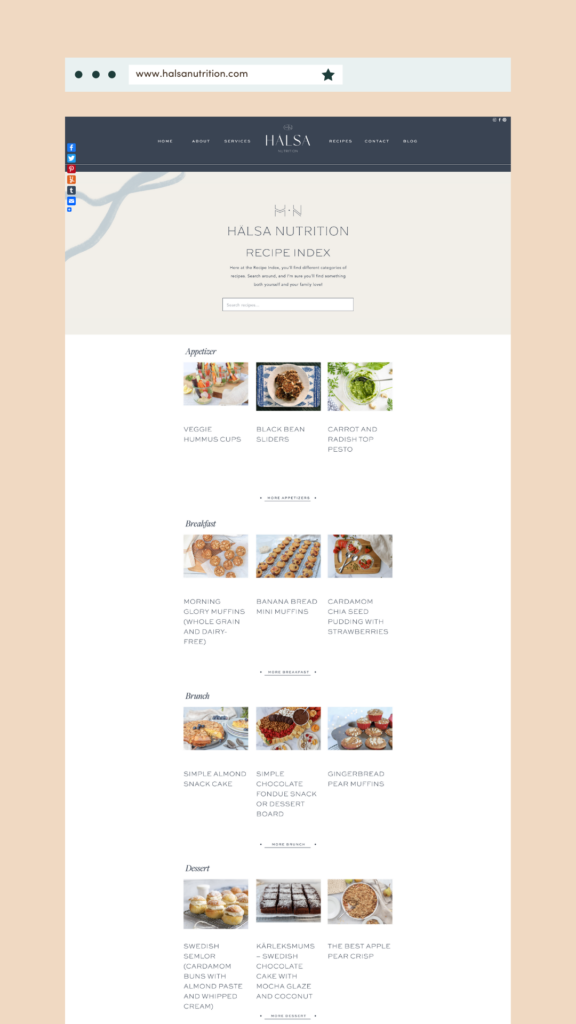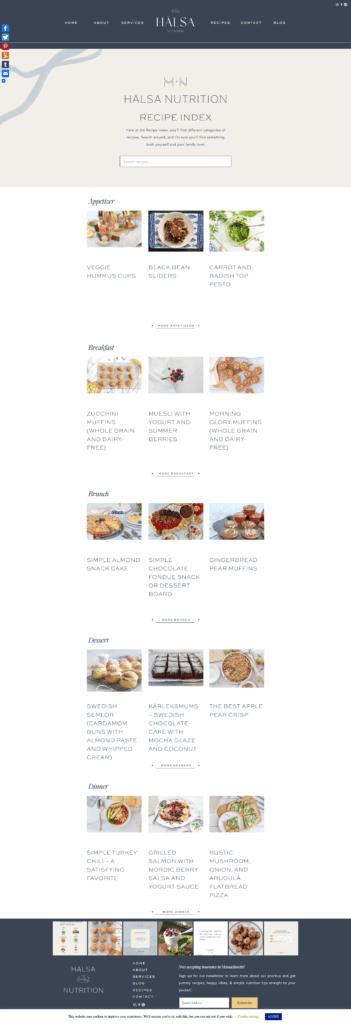
If you’re a business owner and have a website, one of the main goals we all have in common is to increase your website traffic. Your website traffic can have a direct correlation to exposure, sales, clicks, email sign-ups, etc. So, we want to ensure we’re optimizing our time– creating things that are going to pay-off in the long term.
In today’s blogpost, we’re covering one of the best ways for a Registered Dietitian to increase their website traffic. This method is something we follow with nearly all of our clients who have a bunch of recipes and actually enjoy writing content about their recipes.
As a Registered Dietitian, it’s really common that people (even your ideal audience) come to you to find healthy, easy-to-make recipes that they can make at home. Often, these recipes might be found on Pinterest (hint, hint) and always lead back to the website of the recipe owner. Here’s where a Recipe Index comes into play!
A Recipe Index is a page on your website that serves as a large “bowl” of all of your recipes on one page. It’s normally separated by recipe-type, but all recipes are easily accessible through this one page. It’s actually our most requested page on a Registered Dietitian’s website!

Think of your Recipe Index as a “table of contents” for your recipes and allows users to filter through your available contents without having to search for it on a normal blog page. Using the example from above, you can look at her blog page to see that it’s much harder to filter through her recipes.
It’s important that your Recipe Index stays simple for the user experience– you don’t want to make it hard to navigate and you don’t want to overwhelm someone with too many recipes all at once. It needs to be organized, simple and doing its purpose of organizing your recipes.
Be sure to include at least 4 different recipe categories.
In order to have a purposeful Recipe Index, we need recipe categories. The most common categories to have are breakfast, lunch, snacks, dinner. However, you can choose to separate them however you’d like! It’s our recommendation to not have more than 8 categories on your Recipe Index, because remember: we don’t want to overwhelm our users!
Include a “load more” button that links to a Category page.
Unlike the main Blog page, we don’t want our Recipe Index to display hundreds of posts with numerous pages to filter through. It’s recommended to only display 4-6 posts for each category and then include a “load more” button underneath where users can then click to link to a category page. Using our sample from above, this is a sample Category page that we’ve created for our client. This category page is setup similarly to a main blog page, but only contains posts in a certain category.
Always include a search bar.
To add more into the user experience of your website, a search bar is a necessity on your Recipe Index. This can allow the user to quickly search a keyword and find it on your website. Designer tip: don’t forget to design your Search Results pages! This is where that comes into play!
Pinterest is a great marketing platform for dietitians [and any business owner] because your recipes can easily be repurposed and linked back to your website! This is why we recommend the WP Recipe Maker plugin if you are on a WordPress or Showit website– on our sample above, you can see Maria’s recipe card on her single post page where you can easily “Pin Recipe”! We also always install a Pinterest Pin-It plugin so that all images can be pinned to Instagram as well.
Just like the client side, you can also create your own recipe pins, upload them to Pinterest and link them back to the recipe link on your website. This brings website traffic back to your website– most of the time, if someone visits your website for a recipe, they’ll likely stay around to see if you have any additional recipes they may love!
Our team here at Chloe Creative is comprised of designers that specialize in private practice website design and branding. If you are the owner of an online private practice and question if your website is serving you, sign up for a free website audit so we can run some tests on your website. Then, when you’re ready, apply for a discovery call to chat through your details! We’re currently booking for timelines starting in September.
Chat soon,


© Copyright 2018 – 2024 Chloe Creative Studio. Privacy Policy. Terms. North Carolina. Photography by Sara Coffin Photo. Designed by Us :)